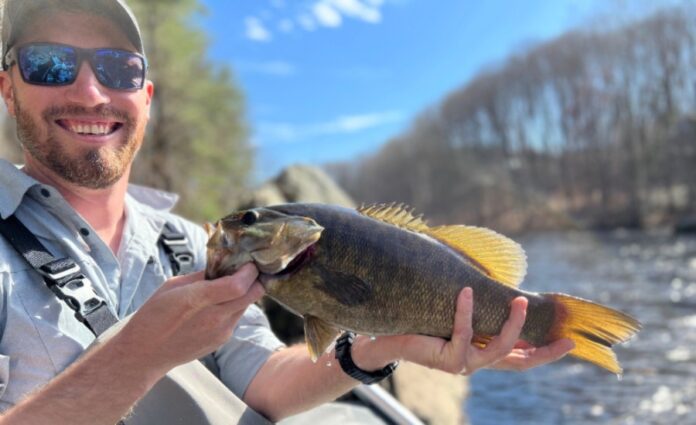Written By: Jay Aylward, The Handmade Angler
Springtime means the beginning of trout season for a lot of fly fishers, but it’s also prime time for pre-spawn smallmouth bass. As river flows and temperatures increase, the biggest smallies in the system begin their migration up into smaller tributaries. These pre-spawn fish are looking for gravel beds that will warm up faster than deeper waters, and bass can travel many miles upstream to find them. Here in Western Massachusetts, our pre-spawn period will last until the water gets into the upper 50s, but once that threshold is reached, you should only focus on deeper water, because the fish will begin actually spawning in the shallower gravel. It may be tempting to target the big fish you see on beds, but that reduces the entire population in the long-term, since abandoned nests will have their eggs eaten within minutes by egg predators who are always hanging nearby. The water won’t be that warm for a few more weeks, though, so here are three tips for fishing the pre-spawners while you still can.

1. Make Precise Casts
Smallmouth like to hold close to rocks or other structure, so they won’t often move very far to take a fly. That means you’ll have to aim your casts carefully, and be very precise with your fly placement. A few inches here or there could make a big difference, so if you don’t hit your target on the first try, it might be worth making another cast to that same spot.
2. Stagger your Retrieve
A challenge that I frequently encounter when bringing trout guys smallmouth fishing is that they want to strip streamers too fast. Pre-spawn smallmouth like a specific cadence: a sharp, 6- to 18-inch strip or two, followed by a long pause. Use flies that drop and “breathe” without a lot of stripping–such as the mini Drunk and Disorderly–since the fish tend to eat the fly during the pause, and so it needs to look alive even when it’s just drifting.

3. Set on Everything
Smallmouth take food more subtly than trout, typically getting within a couple inches of the fly and inhaling it from the back. The eat often feels like you struck a rock or some other obstruction, so don’t get complacent. Set the hook on everything, and set it hard. Yes, that means you will lose some flies, but much more importantly, you won’t miss the big fish. A 20-inch smallmouth is about 10 to 12 years old, which means it has seen almost everything already, and has become a lot more wary than the smaller ones.
Jay Aylward is owner and operator of The Handmade Angler in Leverett, MA.
Credit: Source link






























